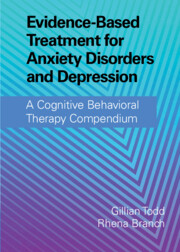 Evidence-Based Treatment for Anxiety Disorders and Depression
Evidence-Based Treatment for Anxiety Disorders and Depression Book contents
- Evidence-Based Treatment for Anxiety Disorders and Depression
- Evidence-Based Treatment for Anxiety Disorders and Depression
- Copyright page
- Contents
- Figures
- Tables
- Contributors
- 1 Introduction
- 2 The History and Philosophical Underpinnings of CBT:
- Part One Cognitive Behavioral Therapy for Anxiety Disorders
- Part Two Cognitive Behavioral Therapy for Posttraumatic Stress Disorder
- Part Three Cognitive Behavioral Therapy for Obsessive-Compulsive Disorder and Associated Disorders
- 11 Obsessive-Compulsive Disorder:
- 12 CBT for OCD:
- 13 Obsessive Compulsive Disorder:
- 14 Other Specified and Unspecified Obsessive-Compulsive and Related Disorders
- 15 A Cognitive Behavioral Approach to Body Dysmorphic Disorder:
- 16 Comprehensive Behavioral Treatment for Trichotillomania (Hair Pulling Disorder) and Excoriation (Skin Picking) Disorder
- 17 Cognitive Behavioral Therapy for Hoarding Disorder
- Part Four Cognitive Behavioral Therapy for Depression
- Part Five Complexity and Comorbidity in Anxiety Disorders and Depression:
- Part Six Specialist Applications of Cognitive Behavioral Therapy for Anxiety Disorders and Depression
- Part Seven Future Developments
- Appendices
- Index
- References
16 - Comprehensive Behavioral Treatment for Trichotillomania (Hair Pulling Disorder) and Excoriation (Skin Picking) Disorder
from Part Three - Cognitive Behavioral Therapy for Obsessive-Compulsive Disorder and Associated Disorders
Published online by Cambridge University Press: 06 January 2022
- Evidence-Based Treatment for Anxiety Disorders and Depression
- Evidence-Based Treatment for Anxiety Disorders and Depression
- Copyright page
- Contents
- Figures
- Tables
- Contributors
- 1 Introduction
- 2 The History and Philosophical Underpinnings of CBT:
- Part One Cognitive Behavioral Therapy for Anxiety Disorders
- Part Two Cognitive Behavioral Therapy for Posttraumatic Stress Disorder
- Part Three Cognitive Behavioral Therapy for Obsessive-Compulsive Disorder and Associated Disorders
- 11 Obsessive-Compulsive Disorder:
- 12 CBT for OCD:
- 13 Obsessive Compulsive Disorder:
- 14 Other Specified and Unspecified Obsessive-Compulsive and Related Disorders
- 15 A Cognitive Behavioral Approach to Body Dysmorphic Disorder:
- 16 Comprehensive Behavioral Treatment for Trichotillomania (Hair Pulling Disorder) and Excoriation (Skin Picking) Disorder
- 17 Cognitive Behavioral Therapy for Hoarding Disorder
- Part Four Cognitive Behavioral Therapy for Depression
- Part Five Complexity and Comorbidity in Anxiety Disorders and Depression:
- Part Six Specialist Applications of Cognitive Behavioral Therapy for Anxiety Disorders and Depression
- Part Seven Future Developments
- Appendices
- Index
- References
Summary
Both hair pulling disorder (trichotillomania) and skin picking disorder (excoriation disorder) are legitimate clinical disorders that are neither rare nor benign. For almost half a century, habit reversal training (HRT) has dominated the clinical literature as treatment for these body-focused repetitive behaviors (BFRBs), yet clinicians and researchers have recognized the limitations of this treatment and have utilized numerous treatment modifications in attempts to bolster its effectiveness. Comprehensive behavioral (ComB) treatment, a newer approach to BFRB treatment, has been described in professional publications and is widely used by expert BFRB clinicians The ComB treatment model provides a guiding, comprehensive, conceptual framework that encompasses and integrates sensory, cognitive, affective, motor, and environmental variables into an individualized treatment package geared to the unique clinical phenomenology of each patient. In this chapter, ComB treatment is described in detail and an illustrative case highlights its unique advantages over other BFRB treatments.
Keywords
- Type
- Chapter
- Information
- Evidence-Based Treatment for Anxiety Disorders and DepressionA Cognitive Behavioral Therapy Compendium, pp. 316 - 340Publisher: Cambridge University PressPrint publication year: 2022


